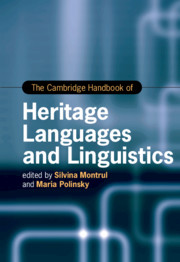Book contents
- The Cambridge Handbook of Heritage Languages and Linguistics
- Cambridge Handbooks In Language And Linguistics
- The Cambridge Handbook of Heritage Languages and Linguistics
- Copyright page
- Dedication
- Contents
- Figures and Tables
- Contributors
- Acknowledgments
- Introduction
- Part I Heritage Languages around the World
- Part II Research Approaches to Heritage Languages
- 15 Heritage Language Research and Theoretical Linguistics
- 16 The Emergence of Heritage Language
- 17 Sociolinguistic Approaches to Heritage Languages
- 18 The Psycholinguistics of Heritage Languages
- 19 Contact Linguistics and Heritage Languages
- 20 A Narrative-Ethnographic Approach to Research on Heritage Language Development
- 21 Corpus-Based Methodologies in the Study of Heritage Languages
- 22 Current Trends and Emerging Methodologies in Charting Heritage Language Grammars
- Part III Grammatical Aspects of Heritage Languages
- Part IV Heritage Language Education
- Index
- References
15 - Heritage Language Research and Theoretical Linguistics
from Part II - Research Approaches to Heritage Languages
Published online by Cambridge University Press: 04 November 2021
- The Cambridge Handbook of Heritage Languages and Linguistics
- Cambridge Handbooks In Language And Linguistics
- The Cambridge Handbook of Heritage Languages and Linguistics
- Copyright page
- Dedication
- Contents
- Figures and Tables
- Contributors
- Acknowledgments
- Introduction
- Part I Heritage Languages around the World
- Part II Research Approaches to Heritage Languages
- 15 Heritage Language Research and Theoretical Linguistics
- 16 The Emergence of Heritage Language
- 17 Sociolinguistic Approaches to Heritage Languages
- 18 The Psycholinguistics of Heritage Languages
- 19 Contact Linguistics and Heritage Languages
- 20 A Narrative-Ethnographic Approach to Research on Heritage Language Development
- 21 Corpus-Based Methodologies in the Study of Heritage Languages
- 22 Current Trends and Emerging Methodologies in Charting Heritage Language Grammars
- Part III Grammatical Aspects of Heritage Languages
- Part IV Heritage Language Education
- Index
- References
Summary
Our understanding of the syntax of natural language and syntactic aspects that obtain across languages and other aspects that display variation has greatly benefited from research on a large number of languages representing a diversity of language families learned natively in their own contexts. We have a better understanding, for example, of the complexity of word order, agreement, case, questions, relative clauses, anaphoric dependencies, etc. As our empirical generalizations continue to be sharpened and refined, the Generative approach, particularly in its Minimalist version, has also been focusing on isolating properties of core syntax, such as Merge (both Internal and External) and the features and units that go into building syntactic structure and driving the different syntactic dependencies. Research on heritage languages has the potential to contribute to that debate. This chapter discusses some of the results of that research and its implications for the debate about Merge, movement, and the notion of root as an essential building block of syntactic structure.
- Type
- Chapter
- Information
- The Cambridge Handbook of Heritage Languages and Linguistics , pp. 375 - 398Publisher: Cambridge University PressPrint publication year: 2021
References
- 2
- Cited by



